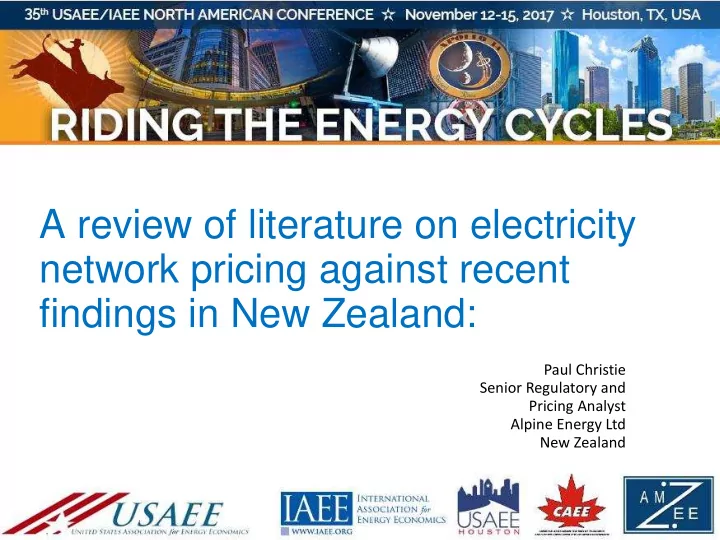

A review of literature on electricity network pricing against recent findings in New Zealand: Paul Christie Senior Regulatory and Pricing Analyst Alpine Energy Ltd New Zealand
Greetings from New Zealand Source: espn.co.uk
Overview • NZ electricity network companies (ENC) under pressure to implement cost reflective pricing. • Industry working group (FPWG) established. • FPWG conducts a literature review, produces a technical paper, and receives submissions. • An NZ ENC (TLC) that direct bills end users with demand charges is reviewed by the regulator. • The purpose of this presentation is to compare the literature reviewed against the findings from the FPWG and review of TLC.
Results from literature review Areas of agreement in the literature: • Recovery of costs with a charge that reflects the nature of the cost • Legacy two part tariffs are not adequate • LRMC appropriate to recover future capacity costs • Demand charges best reflect network costs • Implementation requires good communication • Implementation options Areas without agreement: • The effectiveness of DP to lower peak congestion • Consumer acceptance of DP • Consumer acceptance of demand charges • Efficiency versus other principles of rate design Technical vs social/political considerations
The New Zealand situation Source: http://www.transport.govt.nz Source: www.ea.govt.nz/dmsdocument/20410 Source: https://www.emi.ea.govt.nz
FPWG outcomes Source: www.ena.org.nz Source: Consumer NZ
Electricity Authority review of TLC “ Sandra Greenslade of the Turangi Tongariro Residents Association said people were using barbecues through winter instead of a stove and having a fireplace is a must .” RadioNZ interview (18 July 2017) Source: Stuff.co.nz
Summary of EA review of TLC cont. • Key statistical results from UMR Research survey of 500 consumers: • 39% of respondents did not understand pricing • 45% of respondents felt they were adversely affected • 35% of respondents want to change the billing or pricing structure • Customers from regions with high holiday home concentration were more engaged, and concerned • Only 14% used technologies to monitor use
Review of NZ findings against literature A comparison of areas without agreement to NZ findings • The effectiveness of DP to lower peak congestion-TLC consumers changed behaviour in response to demand charges • Consumers may not accept DP-Consumers have a strong preference for TOU charges with peak off peak ratio • Consumers may not accept demand charges- Consumers ultimately rejected network peak demand charges • Efficiency may not be the most important feature of rate design- preference for ‘equity’, simplicity and charges which are actionable
Conclusions • Agreement with a technical approach to lower long run costs to ENCs and to consumers. • But predicting consumer behaviour difficult. • Consumers more likely to reject DP/demand charges if: • charges complex • delays between actions and changes to price • perceived lack of equity • uncertainty of when peak times occur • load control and peak pricing times are linked. • Need to engage well, keep simple , and implement over time. • Otherwise a preference from NZ consumers for a TOU charge: • more likely to be passed through by retailers • more likely to be accepted and understood • may have less issues with data and privacy • less complex than demand charges • considered to be more equitable. • Also strong preference to rate equity, simplicity, and actionable pricing, alongside efficiency. • But what are the trade offs for implementing TOU (peak/off-peak) charges? LRMC?
Areas for further research • To soon to predict likely consumer responses? • The cost of not adopting cost reflective prices? • The trade-off between fixed and dynamic tariffs. • Consumer acceptance of unpredictable pricing periods and impact on well being. • The strength of the pricing signal and its impact on efficient investment in new technologies. • The impact of new technologies (informing consumers of peak periods) on behaviour. • Appropriate pricing when the price signal may not be passed through. • The trade-off between efficiency, simplicity and consumer choice.
Areas for further research cont . • Understanding and predicting consumer responses to DP; behavioural economics and Bayesian statistics? Transactional analysis? • Understanding the political and social context that consumers operate in. • Effect of education, and income on consumer responses to DP. • Types of management structures appropriate for retailers and ENCs to adopt to solve ‘wicked’ problems- one party’s solution is another party’s problem.
Questions? Source: www.alamy.com
Paul Christie Senior Analyst Pricing and Regulatory Alpine Energy Ltd New Zealand paul.christie@alpineenergy.co.nz +6436874300
Recommend
More recommend